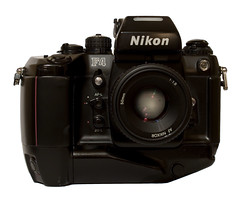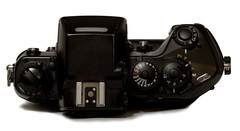Difference between revisions of "Nikon F4"
Rebollo fr (talk | contribs) (link) |
Timmy Toucan (talk | contribs) (un-stubbed; pics) |
||
| Line 1: | Line 1: | ||
| − | + | <div class="floatright plainlinks" style="text-align: center;"> | |
| − | There are three | + | [http://www.flickr.com/photos/timmythesuk/1771453452/in/pool-camerapedia/ http://farm3.static.flickr.com/2112/1771453452_4db77f0f55_m.jpg] |
| − | * '''F4''' | + | ''Nikon F4S''</div> |
| − | * '''F4S''' | + | Nikon's flagship camera from 1988 until the release of the [[Nikon F5|F5]] in 1996, the F4 is still considered by many to be one of the most capable, tough and ergonomically brilliant professional 35mm cameras ever made. |
| − | * '''F4E''' | + | |
| − | The | + | There are nominally three model names for the F4, dependent on the battery pack attached. The basic body is the same for all three models; the battery packs affect the number of batteries used, film drive speed, and additional functionality offered. |
| + | |||
| + | The three models/battery packs are: | ||
| + | |||
| + | * '''F4''' - MB-20 - Holds 4x AA batteries. No vertical grip. 4fps film advance. | ||
| + | * '''F4S''' - MB-21 - Holds 6x AA batteries. Vertical grip/shutter release. 5.7fps film advance. | ||
| + | * '''F4E''' - MB-23 - Holds 6x AA batteries, can also use the high-capacity MN-20 battery pack. Bulkier vertical grip/shutter release than the MB-21. 5.7fps film advance. | ||
| + | |||
| + | The F4 is a truly modular 35mm SLR, with a full range of interchangeable grips, finders, backs and of course lenses. The F4 can meter with manual Nikkor lenses, and also provides autofocus, aperture control and metering with Nikon's more modern lenses. | ||
| + | |||
| + | <div class="floatleft plainlinks" style="text-align: center;"> | ||
| + | [http://www.flickr.com/photos/timmythesuk/1771456968/in/pool-camerapedia/ http://farm3.static.flickr.com/2254/1771456968_2c61f62cb3_m.jpg] | ||
| + | |||
| + | [http://www.flickr.com/photos/timmythesuk/1771445656/in/pool-camerapedia/ http://farm3.static.flickr.com/2069/1771445656_59e44d025e_m.jpg] | ||
| + | </div> | ||
| + | There are three continuous drive modes on the F4: Ch, Cl and Cs for High, Low and Quiet modes. The speed of the film advance is driven by the battery pack attached. The F4 also features manual or automatic film rewind, optional viewfinder information illumination, and fingertip control buttons for metering, focus and aperture lock. | ||
| + | |||
| + | Available metering modes are determined by the model of viewfinder attached. The standard model finder (DP-20) features spot, centre-weighted and matrix metering. The range of finders available includes a waist-level finder, high-magnification finder and a large-format viewfinder for using the camera in situations where you cannot bring your eye to the viewfinder. | ||
== Links == | == Links == | ||
Revision as of 01:23, 28 October 2007
Nikon's flagship camera from 1988 until the release of the F5 in 1996, the F4 is still considered by many to be one of the most capable, tough and ergonomically brilliant professional 35mm cameras ever made.
There are nominally three model names for the F4, dependent on the battery pack attached. The basic body is the same for all three models; the battery packs affect the number of batteries used, film drive speed, and additional functionality offered.
The three models/battery packs are:
- F4 - MB-20 - Holds 4x AA batteries. No vertical grip. 4fps film advance.
- F4S - MB-21 - Holds 6x AA batteries. Vertical grip/shutter release. 5.7fps film advance.
- F4E - MB-23 - Holds 6x AA batteries, can also use the high-capacity MN-20 battery pack. Bulkier vertical grip/shutter release than the MB-21. 5.7fps film advance.
The F4 is a truly modular 35mm SLR, with a full range of interchangeable grips, finders, backs and of course lenses. The F4 can meter with manual Nikkor lenses, and also provides autofocus, aperture control and metering with Nikon's more modern lenses.
There are three continuous drive modes on the F4: Ch, Cl and Cs for High, Low and Quiet modes. The speed of the film advance is driven by the battery pack attached. The F4 also features manual or automatic film rewind, optional viewfinder information illumination, and fingertip control buttons for metering, focus and aperture lock.
Available metering modes are determined by the model of viewfinder attached. The standard model finder (DP-20) features spot, centre-weighted and matrix metering. The range of finders available includes a waist-level finder, high-magnification finder and a large-format viewfinder for using the camera in situations where you cannot bring your eye to the viewfinder.
Links
- F4 review
- F4 FAQ list
- The Nikon F4 including user discussion at Nikongear.com
- Nikon F4 repair notes at Robert Ian Axford's Camera Works


